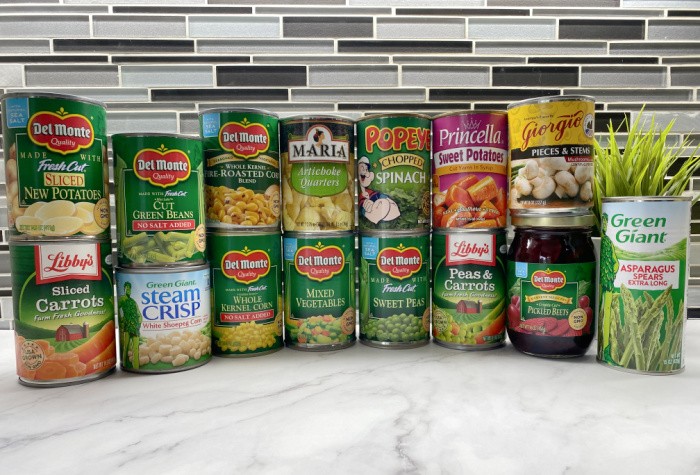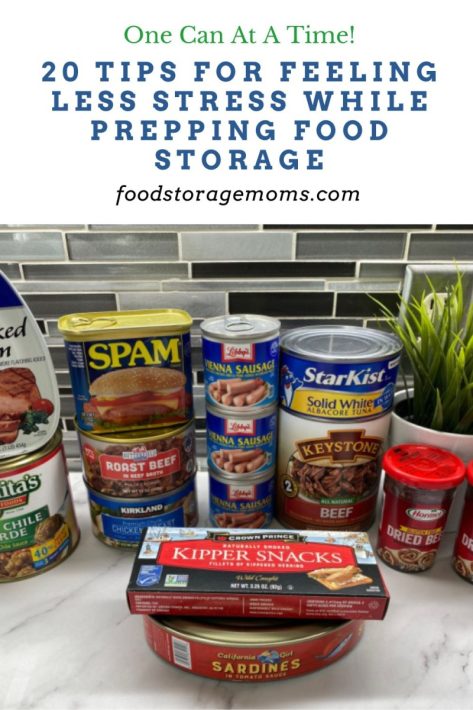
Well-prepped food storage can bring peace of mind in times of uncertainty. However, the process of prepping food storage can sometimes be overwhelming, leading to stress and anxiety. To help alleviate this, I want to share 20 tips for feeling less stressed while prepping food. Large Can Openers and Regular Size Can Openers or Electric Can Openers (Arthritis Hands)
There are some basic ideas that if followed, make the effort to be prepared with the right foods in the quantities needed. It doesn’t have to happen all at once. The key is having a plan and sticking with it.

20 Tips For Feeling Less Stress While Prepping Food Storage
1. Start Small, Think Big
Begin with a manageable goal for your food storage. Start by prepping for a week, then gradually expand to a month, and so on. Breaking it down into smaller tasks can make the process less exhausting. It can also help you stretch your dollars. I’ve always told my readers that you don’t want to go into debt with food storage inventory. 20 Easy Spring Cleaning Tasks You Can Do Today
2. Create a Plan
Develop a detailed plan outlining what foods you need, how much you need, and how long you want your storage to last. Having a plan will keep you organized and focused during the prep process. How to Kick Start Your Food Storage Plan
There are items that qualify for long-term food storage like rice, pasta, and wheat. There are other items that are more prone to spoilage, like flour. Your plan should take into account what’s best for your emergency food supply based on the makeup of your family, the space you have, and the types of foods that bring the best nutritional value.
3. Inventory Check
Before you start prepping, take inventory of what you already have. This will prevent overbuying and ensure you use up items that might expire soon. How to Keep Track of Your Stockpile Inventory It may be best if you have your long-shelf-life items separate from your shorter-term items. That way, when it comes to checking for expiration dates you don’t have to evaluate as many items.
4. Diversify Your Staples
Don’t rely solely on canned goods. Include a variety of staples like grains, legumes, dried fruits, and nuts to add nutritional diversity to your storage. 20 Staple Pantry Items for Making Cheap Meals Your family will learn to use and like more things, making food preparation more unique and enjoyable.
I have a ton of freeze-dried foods. It’s amazing the wide variety of long term storage items I have in #10 cans. I have fruits, vegetables, and even meat items on my pantry shelves. The are few things listed as needed ingredients for meal prep that I don’t have available. I don’t find the joy I used to when visiting food stores. Mark does most of the weekly shopping and we discuss what’s needed from Thrive Life when it comes to the freeze-dried items.
5. Storage Rotation System
Implement a rotation system where you use older items first and replenish them with newer ones. This ensures that nothing goes to waste and that your storage remains fresh. Effective Ways To Prepare For Food Shortages
If the tags on the containers aren’t labeled such that you can read expiration dates, or even processed dates, take a marker and do your own labeling so the rotation efforts are more efficient.
6. Proper Storage Containers
Invest in quality storage containers that are airtight and moisture-proof to keep your food items fresh for longer periods. Best Plastic Containers for Food Storage
You can put some short-term items in plastic bags in the refrigerator or freezer, but for the long-term items they need to be airtight, sturdy, and stackable. I love my 5 and 6-gallon buckets with gamma lids. I have them identified by the color of the buckets or lids. It helps me a lot to identify what I have, and I sleep better knowing I’m ready for the next power outage, emergency, or various natural disasters.
7. Label Everything
Labeling your containers with the contents and expiration dates will help you quickly identify what you have and when it needs to be used or replaced. How to Properly Reuse Ziploc™ Bags, My Favorite Label Maker
8. Consider Shelf Life
When choosing foods for storage, please pay attention to their shelf life. Opt for items with more extended shelf lives to minimize the need for frequent replacements. 50-Year Shelf Life Canned Water-Blue Can Pure Water
As mentioned, that’s why I’ve planned so much of my food storage around freeze-dried foods. They last a long time, don’t have to be rehydrated, and can be a fun treat right out of the can.
9. Meal Planning
Plan meals around your food storage items to ensure you use them efficiently and rotate your stock regularly. 10 Meals to Make When You’re Low on Food
Some foods will have to be tried out. Make sure your family, especially the kids, like what you have available to eat. Also, the preparation may be different between food types, so get some recipe books and learn the best approaches to meal preparation.
10. Learn Food Preservation Techniques
Explore food preservation methods like canning, dehydrating, and freezing to extend the shelf life of perishable items. I’ve got several posts in my archive to help you out. I recently wrote one detailing the benefits of using a dehydrator to save money and use your homegrown foods.
11. Stock Up on Spices and Condiments
Spices and condiments can add flavor and variety to your meals, making them more enjoyable. Stock up on various spices and seasonings to enhance your food storage options. Spices to Have in Your Pantry
12. Emergency Kit
In addition to food, assemble an emergency kit with essential items like water, first aid supplies, flashlights, and batteries to be prepared for any situation. Very Basic Steps for Starting Emergency Prepping Remember that those canned goods will need a quality can opener to access the contents and the dehydrated items will need water for cooking and meal prep.
Many sources suggest one gallon of water per person per day. I suggest 4 gallons of water per person per day to cover hydration, cooking, personal hygiene, and limited laundry.
13. Bulk Buying
Consider buying in bulk to save money and reduce the frequency of shopping trips. Just make sure you have adequate storage space and that the items are things you will use. 20 Ways to Make Your Food Budget Stretch Further
14. Include Comfort Foods
Don’t forget to include comfort foods and treats in your storage. Having familiar foods during stressful times can provide comfort and normalcy. 25 Ways to Use Up Chicken I’d have jams, jellies, peanut butter, crackers, juices, soups, and other items that bring back fond memories of family meals and quick treats after school.
I also have oats for cookies, cereal, and other recipes. We need grains for nutrition and a healthy lifestyle.
15. Involve the Family
Get your family involved in the food prep process. Not only does it lighten the workload, but it also teaches valuable skills and fosters a sense of teamwork. How to Help Your Family Organize Important Documents
16. Stay Organized
Keep your storage area organized and tidy. Knowing where everything is will save you time and reduce stress when accessing your food storage. 20 Tips For Organizing a Super Messy Pantry
17. Stay Informed
Stay informed about food safety guidelines and best storage practices to ensure that your food storage remains safe.
18. Budget Wisely
Set a budget for your food storage efforts and stick to it. Look for sales, discounts, and coupons to stretch your budget further. How To Cut Your Budget When You Think You Can’t
19. Don’t Procrastinate
Start prepping your food storage as soon as possible. The earlier you start, the more prepared you’ll be for any unforeseen events.
20. Practice Gratitude
Lastly, practice gratitude for the abundance of food that you have. Taking a moment to appreciate what you have can help shift your focus from stress to gratitude. Thriving with Less: How to Get By With Less
More Tips: Tips For Feeling Less Stress While Prepping Food Storage
- Managing the Mental Stress of Prepping
- 20 Simple Secrets To Host A Stress-Free Party
- 15 Street Smarts Skills We All Need
Final Word
Prepping food storage doesn’t have to be a stressful endeavor. Remember, it’s not just about stockpiling supplies; it’s about creating a sense of security for your family when times are hard. May God Bless this World, Linda
The post 20 Tips For Feeling Less Stress While Prepping Food Storage appeared first on Food Storage Moms.
